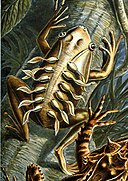ไฟล์:Haeckel Batrachia.jpg

ขนาดของตัวอย่างนี้: 424 × 599 พิกเซล ความละเอียดอื่น: 170 × 240 พิกเซล | 339 × 480 พิกเซล | 543 × 768 พิกเซล | 724 × 1,024 พิกเซล | 2,323 × 3,284 พิกเซล
ดูภาพที่มีความละเอียดสูงกว่า (2,323 × 3,284 พิกเซล, ขนาดไฟล์: 2.17 เมกะไบต์, ชนิดไมม์: image/jpeg)
ประวัติไฟล์
คลิกวันที่/เวลาเพื่อดูไฟล์ที่ปรากฏในขณะนั้น
| วันที่/เวลา | รูปย่อ | ขนาด | ผู้ใช้ | ความเห็น | |
|---|---|---|---|---|---|
| ปัจจุบัน | 10:17, 24 กุมภาพันธ์ 2549 |  | 2,323 × 3,284 (2.17 เมกะไบต์) | Ragesoss | improve version, based on same original scan |
| 07:22, 11 กุมภาพันธ์ 2549 |  | 2,318 × 3,280 (2.21 เมกะไบต์) | Ragesoss | The 68th plate from Ernst Haeckel's 1899 ''Kunstformen der Natur'', depicting frogs classified as Batrachia. Category:Ernst Haeckel |
หน้าที่มีภาพนี้
หน้าต่อไปนี้ โยงมาที่ภาพนี้:
การใช้ไฟล์ข้ามโครงการ
วิกิอื่นต่อไปนี้ใช้ไฟล์นี้:
- การใช้บน arz.wikipedia.org
- การใช้บน ast.wikipedia.org
- การใช้บน az.wikipedia.org
- การใช้บน ban.wikipedia.org
- การใช้บน be.wikipedia.org
- การใช้บน bg.wikipedia.org
- การใช้บน ca.wikipedia.org
- การใช้บน ca.wikibooks.org
- การใช้บน ceb.wikipedia.org
- การใช้บน ckb.wikipedia.org
- การใช้บน dag.wikipedia.org
- การใช้บน de.wikipedia.org
- การใช้บน din.wikipedia.org
- การใช้บน el.wikipedia.org
- การใช้บน en.wikipedia.org
- Wikipedia:Featured pictures thumbs/04
- Wikipedia:Picture of the day/June 2006
- User:Ragesoss/Haeckel
- Wikipedia:Featured picture candidates/Haeckel Batrachia.jpg
- Wikipedia:Wikipedia Signpost/2006-03-13/Features and admins
- Wikipedia:Featured picture candidates/March-2006
- Talk:Frog/Archive 3
- User talk:Ragesoss/Archive1
- Wikipedia:Picture of the day/June 12, 2006
- Wikipedia:POTD/June 12, 2006
- Wikipedia:POTD column/June 12, 2006
- Wikipedia:POTD row/June 12, 2006
- Kunstformen der Natur
- User:Samsara/Frog/Stable
- User:RichardF/POTD
- Wikipedia:WikiProject Germany/Gallery
- User talk:RichardF
- User:Froggyyes~enwiki
- Wikipedia:Featured pictures/Animals/Amphibians
- Unclean spirit
- User:Xophist/s5
- Wikipedia:Wikipedia Signpost/2006-03-13/SPV
- Portal:Amphibians
- Talk:Alfred Russel Wallace/Archive 1
- Portal:Amphibians/Selected picture
ดูการใช้ข้ามโครงการเพิ่มเติมของไฟล์นี้







